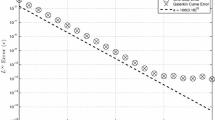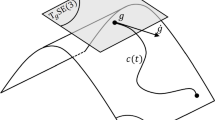Abstract
The purpose of this paper is to extend the symmetric representation of the rigid body equations from the group SO (n) to other groups. These groups are matrix subgroups of the general linear group that are defined by a quadratic matrix identity. Their corresponding Lie algebras include several classical semisimple matrix Lie algebras. The approach is to start with an optimal control problem on these groups that generates geodesics for a left-invariant metric. Earlier work by Bloch, Crouch, Marsden, and Ratiu defines the symmetric representation of the rigid body equations, which is obtained by solving the same optimal control problem in the particular case of the Lie group SO (n). This paper generalizes this symmetric representation to a wider class of matrix groups satisfying a certain quadratic matrix identity. We consider the relationship between this symmetric representation of the generalized rigid body equations and the generalized rigid body equations themselves. A discretization of this symmetric representation is constructed making use of the symmetry, which in turn give rise to numerical algorithms to integrate the generalized rigid body equations for the given class of matrix Lie groups.
Similar content being viewed by others
References
V.I. Arnold, Dynamical Systems III. Encyclopedia of Mathematics, vol. 3 (Springer, Berlin, 1988).
A. Bloch, J. Ballieul, P. Crouch, J.E. Marsden, Nonholonomic Mechanics and Control. Interdisciplinary Applied Mathematics, vol. 24 (Springer, Berlin, 2003).
A.M. Bloch, P. Crouch, J.E. Marsden, T.S. Ratiu, The symmetric representation of the rigid body equations and their discretization, Nonlinearity 15, 1309–1341 (2002).
A.M. Bloch, V. Brinzanescu, A. Iserles, J.E. Marsden, T.S. Ratiu, A class of integrable geodesic flows on the symplectic group, preprint (2007).
J. Cardoso, F. Leite, The Moser Veselov equation. Pre-Publicaos do Departamento de Matematic, Universidade de Coimbra (2001).
P. Deift, L.-C. Li, P. Tomei, Loop groups, discrete versions of some classical integrable systems, and rank 2 extensions, Mem. Am. Math. Soc. 100 (1992).
Y.N. Fedorov, Various aspects of n-dimensional rigid body dynamics, Am. Math. Soc. Trans. 168, 141–171 (1995).
I.M. Gelfand, S.V. Fomin, Calculus of Variations (Prentice Hall, New York, 1963) (reprinted by Dover, 2000).
G.H. Golub, C.F. Van Loan, Matrix Computations, 3rd edn. (Johns Hopkins University Press, Baltimore, 1996).
S. Helgason, Differential Geometry, Lie Groups and Symmetric Spaces (Academic, San Diego, 1978).
A. Jeffrey, Inverse Trigonometric and Hyperbolic Functions §2.7, in Handbook of Mathematical Formulas and Integrals, 2nd edn. (Academic, Orlando, 2000), pp. 124–128.
D.E. Kirk, Optimal Control Theory: An Introduction (Dover, New York, 2004).
S.V. Manakov, Note on the integration of Euler’s equations of the dynamics of an n-dimensional rigid body, Funct. Anal. Appl. 10, 253–299 (1976).
J.E. Marsden, T.S. Ratiu, Introduction to Mechanics and Symmetry, 2nd edn. Texts in Applied Mathematics, vol. 17 (Springer, Berlin, 1999).
A.S. Mischenko, A.T. Fomenko, Integrability of Euler equations on semisimple Lie algebras, Sel. Math. Sov. 2, 207–291 (1982).
J. Moser, A. Veselov, Discrete versions of some classical integrable systems and factorization of matrix polynomials, Commun. Math. Phys. 139, 217–243 (1991).
T. Ratiu, The motion of the free n-dimensional rigid body, Ind. Univ. Math. J. 29, 609–629 (1980).
V.S. Varadarajan, Lie Groups, Lie Algebras, and Their Representations (Springer, New York, 1984).
J.A. Wolf, Spaces of Constant Curvature, 2nd edn. (Publish or Perish, Boston, 1972).
H. Yoshimura, J.E. Marsden, Dirac structures in Lagrangian mechanics Part II: Variational structures, J. Geom. Phys. 57, 209–250 (2006).
Author information
Authors and Affiliations
Corresponding author
Additional information
Communicated by Hans Munthe-Kaas.
Dedicated to Professor Arieh Iserles on the Occasion of his Sixtieth Birthday.
Rights and permissions
About this article
Cite this article
Bloch, A.M., Crouch, P.E., Marsden, J.E. et al. Optimal Control and Geodesics on Quadratic Matrix Lie Groups. Found Comput Math 8, 469–500 (2008). https://doi.org/10.1007/s10208-008-9025-1
Received:
Revised:
Accepted:
Published:
Issue Date:
DOI: https://doi.org/10.1007/s10208-008-9025-1




